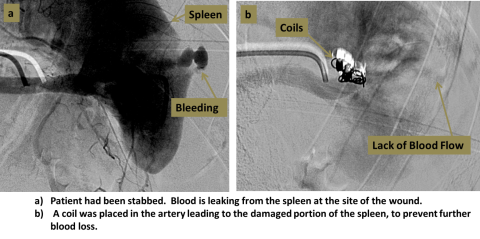Embolization
Find your care
Our board-certified physicians diagnose and treat many vascular conditions. Call 310-481-7545 to learn more about interventional radiology services.
Treatment for:
Internal bleeding, aneurysms, abnormal blood vessels, gastrointestinal bleeding, vascular malformations (Arteriovenous malformations, Venous and Lymphatic Malformations)
Why it’s done:
Embolization procedures allow blockage of blood vessels without invasive surgery. Embolization can be used to stop arterial bleeding, and can also be used to block blood vessels for other reasons, such as to treat tumors, shrink vascular malformations, or re-direct flow.
How it’s done:
An interventional radiologist accesses the femoral artery at the groin. Small catheters and wires are used to navigate into the chosen artery, confirmed with angiography. An occluding substance can then be injected, or small coils can be placed into the artery to block the vessel.

Level of anesthesia:
Conscious sedation
Risks:
Bleeding, infection, non-target embolization (blockage of an artery other than the one intended)
Post-procedure:
Two to six hours of bed rest
Follow-up:
Depends on the clinical situation
For More Information:
For more information or to schedule an appointment with one of our IR physicians, please call 310-481-7545.